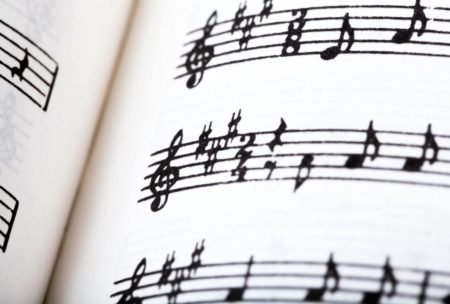Master music creation with proven Music Composition Techniques. Elevate your skills in this comprehensive online course. Enroll today! Read more.
Jason Allen is a PhD in music, and was recently named one of the semi-finalists for the Grammy Foundations "Music Educator" award.
Access all courses in our library for only $9/month with All Access Pass
Get Started with All Access PassBuy Only This CourseAbout This Course
Who this course is for:
- Anyone keen on learning to write music for enjoyment or as a potential new career
- Students who have penned their own songs, seeking to delve deeper into composition
What you’ll learn:
- Craft music using established techniques and valuable insights.
- Create your music using software or the traditional pencil and paper method
- Generate musical ideas through creativity exercises
Requirements:
- Before starting this course, students should know the basics of how to read music
- Extensive music theory training is not necessary for this course.
- For those without any music notation background at all, the course Music Theory Comprehensive Part 1: How To Read Music is highly recommended.
While the typical image of a composer involves envisioning someone in an attic with a grand piano, a big white wig, and the year set in 1800, this perception is outdated. Today’s composers, including myself, are contemporary and relatable.
In this course, I’ll share techniques I use for writing music across styles and situations. With experience in major orchestras, film studios, and video games, I bring a wealth of knowledge. As a Ph.D. in music composition and a university professor, I offer insights based on expertise.
I earned recognition as a semi-finalist for the Grammy Foundation’s Music Educator of the Year award due to my in-person university classes. Now, I’m transitioning these classes online to reach a broader audience and share the joy of Music Theory with more students.
I intend to create multiple sections for this music composition class, with the current offering being Part 2. As the course expands, we will delve progressively deeper into my techniques. This segment centers on cultivating a sense of Tension and Release, a fundamental concept in music composition.
Our Promise to You
By the end of this course, you will have mastered tension and release music composition techniques.
10 Day Money Back Guarantee. If you are unsatisfied for any reason, simply contact us and we’ll give you a full refund. No questions asked.
Learn music composition techniques today and enhance your skills!
Course Curriculum
| Section 1 - Welcome And Overview | |||
| Introduction | 00:00:00 | ||
| My Background | 00:00:00 | ||
| Why Tension And Release? | 00:00:00 | ||
| Review: Tools | 00:00:00 | ||
| [DOWNLOAD] Staff Paper | 00:00:00 | ||
| Review: Process Of Composing | 00:00:00 | ||
| Section 2 - Tension And Release In Form | |||
| Long Term And Short Term | 00:00:00 | ||
| Forms That We Know So Far | 00:00:00 | ||
| Forms That Create Drama | 00:00:00 | ||
| Sonata Form | 00:00:00 | ||
| The Four Elements Of Sonata Form | 00:00:00 | ||
| Sonata Form Examples | 00:00:00 | ||
| Using Sonata Form For Tension And Release | 00:00:00 | ||
| [DOWNLOAD] Moonlight Sonata | 00:00:00 | ||
| Modern Uses Of Form For Tension | 00:00:00 | ||
| Example: Muse (Butterflies And Hurricanes) | 00:00:00 | ||
| Section 3 - Tension And Release In Meter | |||
| Meter And Tension | 00:00:00 | ||
| Stylistic Concerns | 00:00:00 | ||
| Compound Meters | 00:00:00 | ||
| Compound Meter Definition | 00:00:00 | ||
| Compound Meter Signatures | 00:00:00 | ||
| Another Perspective | 00:00:00 | ||
| Alternating Compound And Duple Meters For Tension | 00:00:00 | ||
| Section 4 - Tension And Release In Rhythm | |||
| Rhythmic Patterns | 00:00:00 | ||
| Pattern Obfuscation | 00:00:00 | ||
| Example: Philip Glass (From The Soundtrack To The Truman Show) | 00:00:00 | ||
| [DOWNLOAD] Glass, Truman Sleeps | 00:00:00 | ||
| Example: Aporia | 00:00:00 | ||
| Section 5 - Tension And Release In Harmony | |||
| Consonance And Dissonance | 00:00:00 | ||
| Prolonged Dominant | 00:00:00 | ||
| Emphasized Resolution | 00:00:00 | ||
| Pedal Tones | 00:00:00 | ||
| Long Resolution Of Pedal Tones | 00:00:00 | ||
| Pedal Tones In Higher Voices | 00:00:00 | ||
| Example: Aphex Twin, Ventolin | 00:00:00 | ||
| Section 6 - Combining Techniques | |||
| Using Multiple Techniques | 00:00:00 | ||
| [DOWNLOAD] Sonata In C, Mozart | 00:00:00 | ||
| Example: Kinesthesia, Movement 7 | 00:00:00 | ||
| Film Music And Tension Techniques | 00:00:00 | ||
| Composing Music For Films | 00:00:00 | ||
| Section 7 - Wrap Up | |||
| Coming Soon: Composition Techniques 3: Composing For Film | 00:00:00 | ||
About This Course
Who this course is for:
- Anyone keen on learning to write music for enjoyment or as a potential new career
- Students who have penned their own songs, seeking to delve deeper into composition
What you’ll learn:
- Craft music using established techniques and valuable insights.
- Create your music using software or the traditional pencil and paper method
- Generate musical ideas through creativity exercises
Requirements:
- Before starting this course, students should know the basics of how to read music
- Extensive music theory training is not necessary for this course.
- For those without any music notation background at all, the course Music Theory Comprehensive Part 1: How To Read Music is highly recommended.
While the typical image of a composer involves envisioning someone in an attic with a grand piano, a big white wig, and the year set in 1800, this perception is outdated. Today’s composers, including myself, are contemporary and relatable.
In this course, I’ll share techniques I use for writing music across styles and situations. With experience in major orchestras, film studios, and video games, I bring a wealth of knowledge. As a Ph.D. in music composition and a university professor, I offer insights based on expertise.
I earned recognition as a semi-finalist for the Grammy Foundation’s Music Educator of the Year award due to my in-person university classes. Now, I’m transitioning these classes online to reach a broader audience and share the joy of Music Theory with more students.
I intend to create multiple sections for this music composition class, with the current offering being Part 2. As the course expands, we will delve progressively deeper into my techniques. This segment centers on cultivating a sense of Tension and Release, a fundamental concept in music composition.
Our Promise to You
By the end of this course, you will have mastered tension and release music composition techniques.
10 Day Money Back Guarantee. If you are unsatisfied for any reason, simply contact us and we’ll give you a full refund. No questions asked.
Learn music composition techniques today and enhance your skills!
Course Curriculum
| Section 1 - Welcome And Overview | |||
| Introduction | 00:00:00 | ||
| My Background | 00:00:00 | ||
| Why Tension And Release? | 00:00:00 | ||
| Review: Tools | 00:00:00 | ||
| [DOWNLOAD] Staff Paper | 00:00:00 | ||
| Review: Process Of Composing | 00:00:00 | ||
| Section 2 - Tension And Release In Form | |||
| Long Term And Short Term | 00:00:00 | ||
| Forms That We Know So Far | 00:00:00 | ||
| Forms That Create Drama | 00:00:00 | ||
| Sonata Form | 00:00:00 | ||
| The Four Elements Of Sonata Form | 00:00:00 | ||
| Sonata Form Examples | 00:00:00 | ||
| Using Sonata Form For Tension And Release | 00:00:00 | ||
| [DOWNLOAD] Moonlight Sonata | 00:00:00 | ||
| Modern Uses Of Form For Tension | 00:00:00 | ||
| Example: Muse (Butterflies And Hurricanes) | 00:00:00 | ||
| Section 3 - Tension And Release In Meter | |||
| Meter And Tension | 00:00:00 | ||
| Stylistic Concerns | 00:00:00 | ||
| Compound Meters | 00:00:00 | ||
| Compound Meter Definition | 00:00:00 | ||
| Compound Meter Signatures | 00:00:00 | ||
| Another Perspective | 00:00:00 | ||
| Alternating Compound And Duple Meters For Tension | 00:00:00 | ||
| Section 4 - Tension And Release In Rhythm | |||
| Rhythmic Patterns | 00:00:00 | ||
| Pattern Obfuscation | 00:00:00 | ||
| Example: Philip Glass (From The Soundtrack To The Truman Show) | 00:00:00 | ||
| [DOWNLOAD] Glass, Truman Sleeps | 00:00:00 | ||
| Example: Aporia | 00:00:00 | ||
| Section 5 - Tension And Release In Harmony | |||
| Consonance And Dissonance | 00:00:00 | ||
| Prolonged Dominant | 00:00:00 | ||
| Emphasized Resolution | 00:00:00 | ||
| Pedal Tones | 00:00:00 | ||
| Long Resolution Of Pedal Tones | 00:00:00 | ||
| Pedal Tones In Higher Voices | 00:00:00 | ||
| Example: Aphex Twin, Ventolin | 00:00:00 | ||
| Section 6 - Combining Techniques | |||
| Using Multiple Techniques | 00:00:00 | ||
| [DOWNLOAD] Sonata In C, Mozart | 00:00:00 | ||
| Example: Kinesthesia, Movement 7 | 00:00:00 | ||
| Film Music And Tension Techniques | 00:00:00 | ||
| Composing Music For Films | 00:00:00 | ||
| Section 7 - Wrap Up | |||
| Coming Soon: Composition Techniques 3: Composing For Film | 00:00:00 | ||





very y deep training
the teacher gives some great detail and I sure hope to see more like making music of ads and computer games etc.